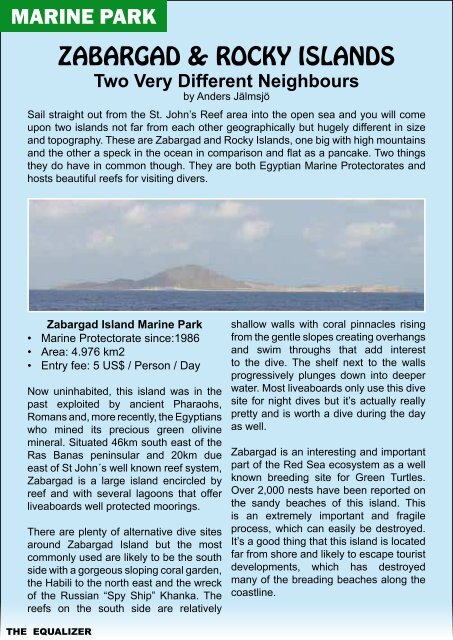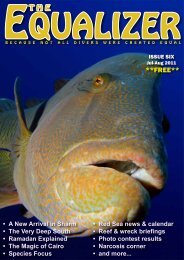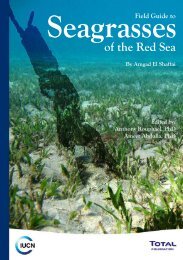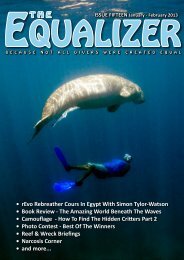FREE** **Enter our photo contest to win a mini-safari trip - aziab media
FREE** **Enter our photo contest to win a mini-safari trip - aziab media
FREE** **Enter our photo contest to win a mini-safari trip - aziab media
Create successful ePaper yourself
Turn your PDF publications into a flip-book with our unique Google optimized e-Paper software.
MARINE PARK<br />
ZABARGAD & ROCKY ISLANDS<br />
Two Very Different Neighb<strong>our</strong>s<br />
by Anders Jälmsjö<br />
Sail straight out from the St. John’s Reef area in<strong>to</strong> the open sea and you will come<br />
upon two islands not far from each other geographically but hugely different in size<br />
and <strong>to</strong>pography. These are Zabargad and Rocky Islands, one big with high mountains<br />
and the other a speck in the ocean in comparison and flat as a pancake. Two things<br />
they do have in common though. They are both Egyptian Marine Protec<strong>to</strong>rates and<br />
hosts beautiful reefs for visiting divers.<br />
Zabargad Island Marine Park<br />
• Marine Protec<strong>to</strong>rate since:1986<br />
• Area: 4.976 km2<br />
• Entry fee: 5 US$ / Person / Day<br />
Now uninhabited, this island was in the<br />
past exploited by ancient Pharaohs,<br />
Romans and, more recently, the Egyptians<br />
who mined its precious green olivine<br />
mineral. Situated 46km south east of the<br />
Ras Banas peninsular and 20km due<br />
east of St John´s well known reef system,<br />
Zabargad is a large island encircled by<br />
reef and with several lagoons that offer<br />
liveaboards well protected moorings.<br />
There are plenty of alternative dive sites<br />
around Zabargad Island but the most<br />
commonly used are likely <strong>to</strong> be the south<br />
side with a gorgeous sloping coral garden,<br />
the Habili <strong>to</strong> the north east and the wreck<br />
of the Russian “Spy Ship” Khanka. The<br />
reefs on the south side are relatively<br />
shallow walls with coral pinnacles rising<br />
from the gentle slopes creating overhangs<br />
and swim throughs that add interest<br />
<strong>to</strong> the dive. The shelf next <strong>to</strong> the walls<br />
progressively plunges down in<strong>to</strong> deeper<br />
water. Most liveaboards only use this dive<br />
site for night dives but it’s actually really<br />
pretty and is worth a dive during the day<br />
as well.<br />
Zabargad is an interesting and important<br />
part of the Red Sea ecosystem as a well<br />
known breeding site for Green Turtles.<br />
Over 2,000 nests have been reported on<br />
the sandy beaches of this island. This<br />
is an extremely important and fragile<br />
process, which can easily be destroyed.<br />
It’s a good thing that this island is located<br />
far from shore and likely <strong>to</strong> escape t<strong>our</strong>ist<br />
developments, which has destroyed<br />
many of the breading beaches along the<br />
coastline.<br />
Rocky Island Marine Park<br />
• Marine Protec<strong>to</strong>rate since:1986<br />
• Area:0.176 km2<br />
• Entry fee: 5 US$ / Person / Day<br />
Just, over 5 km south east of Zabargad<br />
we find Rocky Island. This is a low island<br />
in contrast <strong>to</strong> the high peaks of Zabargad.<br />
The reef surrounding the Island plunges<br />
straight from the <strong>to</strong>p just beneath the<br />
surface down steep walls in<strong>to</strong> the<br />
abyss. Because Rocky is more exposed<br />
<strong>to</strong> weather and <strong>win</strong>d than Zabargad,<br />
liveaboards tend not <strong>to</strong> stay overnight<br />
here.<br />
Diving around Rocky Island is gorgeous<br />
with the traditional Red Sea beauty of soft<br />
coral and anthias. Basically you would<br />
check the currents and conditions and<br />
then dive the side most suitable, but in<br />
general there are always good alternative<br />
dives around the island. The north face<br />
takes the brunt of the prevailing weather<br />
and currents which might offer a slightly<br />
more challenging dive, but the flip side is<br />
the presence of numerous pelagic species<br />
notably hammerheads, grey reef sharks,<br />
as well as large groupers and Napoleon<br />
Wrasse. The coral growth is best on the<br />
east side with beautiful coral formations<br />
and a small plateau.<br />
Rocky is also the location of the wreck of<br />
the Steamship SS Maidan, an impressive<br />
152.4 m long cargo vessel. She made her<br />
final j<strong>our</strong>ney in 1923 and hit the southern<br />
shores of Rocky Island the night of June<br />
9th and sunk the next day in<strong>to</strong> deep water.<br />
Her passengers and crew climbed on<strong>to</strong><br />
the island and were rescued that same<br />
day.<br />
The position of the wreck was uncertain for<br />
a long time, but she was finally discovered<br />
in Oc<strong>to</strong>ber 2003, by Grant Searancke and<br />
Kimmo Hagman. They managed <strong>to</strong> get<br />
the first <strong>pho<strong>to</strong></strong>graphs and video footage of<br />
the wreck. The SS Maidan now lies at a<br />
depth of between 80 <strong>to</strong> 120 m accessible<br />
only <strong>to</strong> experienced Trimix divers.<br />
Top: Green Sea Turtles use Zabargad Island as one of their nesting beaches in the Red Sea<br />
Above: Rocky Island is less imposing than its neighb<strong>our</strong> Zabargad (Opposite)<br />
THE EQUALIZER Sep-Oct 2011





